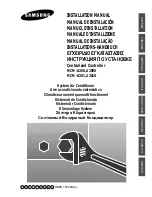
5370598-BIM-C-0518
Johnson Controls Ducted Systems
47
Reset
Remove the call for heating by lowering the thermostat setting
lower than the conditioned space temperature.
Electric Heat Anticipator Setpoints
It is important that the anticipator setpoint be correct. Too high
of a setting will result in longer heat cycles and a greater
temperature swing in the conditioned space. Reducing the
value below the correct setpoint will give shorter “ON” cycles
and may result in the lowering of the temperature within the
conditioned space. Refer to Table 25 for the required electric
heat anticipator setting.
Gas Heating Sequence Of Operations
When the thermostat calls for the first stage of heating, the low-
voltage control circuit from “R” to “W1” is completed. A call for
heat passes through the UCB to the
Ignition Control Board
(ICB).
The UCB monitors the “W1” call and acts upon any call
for heat by monitoring the
Gas Valve (GV).
Once voltage has
been sensed at the GV, the UCB will initiate the fan on delay for
heating, energizing the indoor blower the specified delay has
elapsed.
When the thermostat has been satisfied, heating calls are
ceased. The GV is immediately closed. The blower is de-
energized after the fan off delay for heating has elapsed. The
draft motor performs a 30-second post purge.
Ignition Control Board
First Stage Of Heating
When the ICB receives a call for first stage of heating, “W1,” the
draft motor is energized. Once the draft motor has been proven,
a 30-second purge is initiated. At the end of the purge, the GV
is opened, and the spark ignitor is energized for 10 seconds.
The ICB then checks for the presence of flame. If flame is
detected, the ICB enters a flame stabilization period. If flame
was not detected, the GV closes, and a retry operation begins.
During the flame stabilization period, a loss of the flame for 2
seconds will cause the GV to close and the retry operation to
begin. After the flame stabilization period, a loss of flame for 3/4
second will cause the GV to close and the retry operation to
begin.
At the conclusion of the flame stabilization period, the ICB will
operate the gas heat in high fire for an additional 60 seconds
(for a total for 120 seconds of high fire operation). After this 60
seconds, the ICB will then use the call for the second stage of
heat to control second stage operation of the GV.
When “W1” is satisfied, both valves are closed.
Second Stage Of Heating
When the ICB receives a call for the second stage of heating,
“W2,” the ICB conducts a complete first stage ignition
sequence. If this sequence is satisfied, the second main valve
of the GV is opened.
When “W2” is satisfied, the second main valve is closed.
Retry Operation
When a flame is lost or is not detected during an attempt to
achieve ignition, a retry operation occurs. A 30-second purge is
performed between ignition attempts.
If the unit fails after three ignition attempts, the furnace is
locked-out for one hour. The furnace is monitored during this
one-hour period for unsafe conditions.
Table 24: Electric Heat Limit Setting
UNIT (TONS)
VOLTAGE
HEATER
kW
LIMIT
SWITCH
OPENS °F
ZV-A3 (3)
208/230
3
155
6
155
9
170
15
170
ZV-A4 (4)
208/230
6
155
9
170
15
170
20
170
ZV-A5 (5)
208/230
6
155
9
170
15
170
20
170
24
170
ZV-A3 (3)
480
3
155
6
155
9
170
15
170
ZV-A4 (4)
480
6
155
9
170
15
170
20
170
ZV-A5 (5)
480
6
155
9
170
15
170
20
170
24
170
ZV-A3 (3)
600
9
170
15
170
ZV-A4 (4)
600
9
170
15
170
20
170
ZV-A5 (5)
600
9
170
15
170
20
170
24
170
Table 25: Electric Heat Anticipator Setpoints
SETTING, AMPS
W1
W2
0.13
0.1
















































